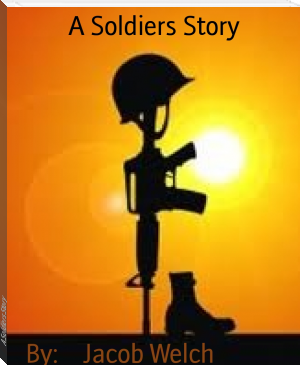The Cowboy Life by By: Jacob Welch (read me a book txt) 📖

- Author: By: Jacob Welch
Book online «The Cowboy Life by By: Jacob Welch (read me a book txt) 📖». Author By: Jacob Welch
Cowboy
Predecessors of the cowboy date back to colonial times. In western Massachusetts, in the uplands of the Carolinas, in Florida, and across the northern, red clay hills of Georgia and Alabama, cattle-raising societies existed long before the Great Plains had been cleared of buffalo. It was in Florida that much of the protocol involving branding evolved. Yet the cattle industry of the Southeast never attracted national attention. The herders never became heroes. They remained little known and were recognized for what they were—illiterate, unmounted trespassers on the public domain, drifting from grazing ground to grazing ground, trailing their beasts to markets at Ohio River towns or to Savannah or Jacksonville.
The cowboy of myth and reality had his beginnings in Texas. There cattle grew wild with few natural enemies; by the end of the Civil War there were an estimated 5 million of them. It was then that the cowboy entered his twenty-year golden age, 1866-1886, the era of the open range and the great cattle drives.
The incentive was the high price of beef up North, where Union armies had exhausted the supply and the urbanizing East provided a ready market. A steer worth four dollars in Texas was worth forty dollars in the North. The economics did not escape the Texans. Beginning in 1866 they began moving long lines of longhorns northward, with the primary destination being the railhead at Sedalia, Missouri. Indians and farmers who resented cattle trampling their crops and spreading the dreaded Texas fever protested their passage. Outlaws stole the cattle and were not averse to killing the men driving them.
Texans searched for a route with better grass and fewer Indians, farmers, and desperadoes. When railroads inched across the plains, new trails, among them the Chisholm, Western, and Loving, veered westward to intercept them. Cattle towns such as Abilene, Wichita, Ellsworth, Caldwell, and Dodge City enjoyed a brief heyday of prosperity and violence. Later trails headed on north to Ogallala, Cheyenne, Glendive, and Miles City. By 1886 the open-range cattle business had spread throughout the Great Plains and had merged with earlier cattle enterprises in Colorado, Idaho, Washington, Utah, Nevada, Arizona, and California.
The men who worked the cattle in the treeless expanses of the West, at least one-fourth of them blacks, became known as cowboys. The image of the courageous, spirited horseman living a dangerous life carried with it an appeal that refuses to disappear. Driving a thousand to two thousand cattle hundreds of miles to market; facing lightning and cloudbursts and drought, stampedes, rattlesnakes, and outlaws; sleeping under the stars and catching chow at the chuckwagon—the cowboys dominated the American galaxy of folk heroes.
Even their dress inspired envy. The cowboys’ hats were high-crowned with wide, floppy rims, practical for protection from the sun’s glare, useful as a cup with which to scoop up water or, folded over, as a pillow. The bandana handkerchief tied around the neck could be lifted to cover mouth and nostrils from dust. Originally the collarless shirt and trousers were nondescript, of flannel or wool. A vest was often worn; it gave some protection from cold winds and also had a number of useful pockets, one of which held Bull Durham tobacco and cigarette papers. The boots with heels two inches high, the better to rest in the stirrups or dig into the ground while roping a calf, may have appeared exotic to a dude, but they were absolutely practical. The stock saddle’s design traced all the way back to the Moors of North Africa, having come to the American cowboy by way of the Spanish and Mexicans. Chaparejos, or chaps, served a valuable purpose when a cowboy had to chase after a steer into a patch of thorny mesquite. A bridle, a lariat, and, during the cattle drives, probably a well-balanced six-shooter completed the cowboys’ outfit.
Ranchers staked out homesteads often centered in a cottonwood grove, with ample water nearby; they grazed their cattle over thousands of acres of public domain. Barbed wire, a web of railroads throughout the Great Plains, and enforcement of federal land laws all put an end to the open-range cattle industry and the great trails. By the mid-1880s prudent cattlemen realized that the industry was overexpanded, the Great Plains overgrazed, and the price of beef declining.
The dry summer of 1886 followed by the terrible winter of 1886-1887 destroyed what remained of the original industry. The open range was ended. Blooded cattle were brought in to improve the stock. The cowboy who hated to work unmounted was often reduced to riding a haymow, mending fences, and applying medicines to sick cattle. Where once he had herded cattle up the trails to Abilene or Dodge, he now ran the line—the water divide between his ranch and his neighbor’s. There was still the semiannual roundup when cowboys representing several ranches rendezvoused and rode great circles, rounding up all the cattle they could find. They were then herded to a central place where cowboys from each ranch cut out its beasts and drove them back to the home range.
Glorified in thousands of novels and hundreds of motion pictures, the American cowboy is so mythologized that the reality and the legend are almost inseparable. Yet the reality is that the cowboy still exists because his work is essential to the industry. In many areas of the American West he still rides a horse, though he may carry it in a horse trailer behind his pickup truck to the point where the road gives out and a horse becomes indispensable. He may survey the ranchman’s spread in a small airplane that he pilots, and he may help his employer determine with a computer matters of feed, weight, and salability. But he still dresses like a cowboy because the garb is practical; he understands cattle and horses and gazes out upon the treeless expanse just as his predecessors did. His work and his workplace, in spite of encroaching population, are still there.
ImprintPublication Date: 02-19-2015
All Rights Reserved
 Nowadays a big variety of genres are exist. In our electronic library you can choose any book that suits your mood, request and purpose. This website is full of free ebooks. Reading online is very popular and become mainstream. This website can provoke you to be smarter than anyone. You can read between work breaks, in public transport, in cafes over a cup of coffee and cheesecake.
Nowadays a big variety of genres are exist. In our electronic library you can choose any book that suits your mood, request and purpose. This website is full of free ebooks. Reading online is very popular and become mainstream. This website can provoke you to be smarter than anyone. You can read between work breaks, in public transport, in cafes over a cup of coffee and cheesecake.




Comments (0)